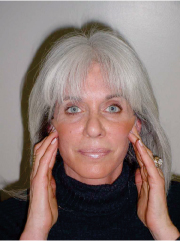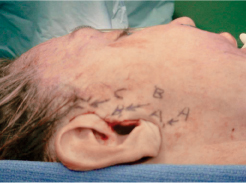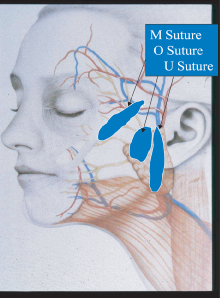13
The S-Lift Rhytidectomy
The wish of many patients seeking facial rejuvenation is for a limited procedure, devoid of complications, with a natural, nonoperated result and a rapid return to regular activities. Patients will often demonstrate their aesthetic desires by lifting the skin of their face with their fingers from the angle of the mandible vertically upward toward the tragus of the ear, a maneuver many of them have repeated endless times in the mirror prior to presenting for consultation (Fig. 13-1). It is important to remember that there is no surgical procedure more elective than facelift surgery. Consequently, cosmetic surgeons must continually strive to maximize results while, at the same time, minimizing complications and postoperative recovery. Patients’ wishes, as just outlined, may not always be shared by cosmetic surgeons, many of whom often prefer a more aggressive surgical facial rejuvenation program. The S-lift procedure as described by Saylan1 can in the properly selected patient achieve many of our patients’ wishes for facial rejuvenation, providing a limited operation with minimal risks and a short recovery period.

Figure 13-1 Patient demonstrating the results she would like to achieve from facelifting. Note the primarily vertical vector of this mock rejuvenation.
The S-Lift facelift, as popularized by Dr. Ziya Saylan, has received much attention around the world. The S-Lift is a conceptually new approach to facelifting and is particularly applicable to younger patients and patients requiring secondary facelifts. It is important to note that the S-Lift is not a simple “mini-lift” skin excision, but is rather an advanced superficial musculoaponeurotic system (SMAS) multiplane rhytidectomy. In this chapter, we also describe what is referred to as the S-Plus Lift. This procedure combines aspects of the technique of lateral SMASectomy described by Baker2,3 and malar fat pad suspension utilizing a purse-string suture, suspending the ptotic malar fat pad from the temporalis fascia (M-suture), described by Tonnard et al.4 The S-Plus Lift extends the efficacy of S-Lift in those patients who have significant midfacial ptosis. The S-Lift is generally a “short flap” facelift procedure, whereas the S-Plus with its midface extension is a “long flap” rhytidectomy.
 Advantages of the S-Lift
Advantages of the S-Lift
 Limited incisions and scars
Limited incisions and scars
 A primarily vertical vector rejuvenation
A primarily vertical vector rejuvenation
 No postauricular scar (ponytail friendly)
No postauricular scar (ponytail friendly)
 Excellent neck and jowl rejuvenation
Excellent neck and jowl rejuvenation
 Reduced surgical time
Reduced surgical time
 Can be combined with platysmaplasty or minimal incision brow lift or buccal fat reduction for further enhancement
Can be combined with platysmaplasty or minimal incision brow lift or buccal fat reduction for further enhancement
 SMAS procedure
SMAS procedure
 Short recovery period
Short recovery period
 Disadvantages of the S-Lift
Disadvantages of the S-Lift
 Limited access to the neck
Limited access to the neck
 Posterior dog ear that can last 1 to 3 months and can often require revision surgery
Posterior dog ear that can last 1 to 3 months and can often require revision surgery
 Pain over the zygomatic arch secondary to the “O” and “U” suture
Pain over the zygomatic arch secondary to the “O” and “U” suture
 Limited improvement on severely ptotic necks
Limited improvement on severely ptotic necks
 Limited improvement in patients with ptotic midface
Limited improvement in patients with ptotic midface
 Key Technical Points
Key Technical Points
 Retrotragal incision, both in men and women, except for smokers in whom a pretragal incision is recommended (Fig. 13-2)
Retrotragal incision, both in men and women, except for smokers in whom a pretragal incision is recommended (Fig. 13-2)
 Preexcision of a limited skin ellipse (always be conservative, especially in secondary facelift cases). Skin only. Stay superficial.
Preexcision of a limited skin ellipse (always be conservative, especially in secondary facelift cases). Skin only. Stay superficial.
 A #15 blade to create thick flaps and demarcate the dissection plane just superficial to the parotid fascia
A #15 blade to create thick flaps and demarcate the dissection plane just superficial to the parotid fascia
 Complete flap elevation under direct vision with facelift scissors
Complete flap elevation under direct vision with facelift scissors
 Extent of undermining determined by extent of mid-face laxity (the greater the midfacial laxity, the greater the undermining)
Extent of undermining determined by extent of mid-face laxity (the greater the midfacial laxity, the greater the undermining)
 Closed and open liposuction only after elevation of flap to maximize flap viability
Closed and open liposuction only after elevation of flap to maximize flap viability

Figure 13-2 S-Lift incision demonstrating three key vectors: A to A1, B to B1, and C to C1.

Figure 13-3 Diagramatic depiction of U suture, O suture, and M suture.
 Identify the extended SMAS platysma (ESP). Grasp the ESP with a long forceps and evaluate the ideal location for elevation and rotation with the U suture.
Identify the extended SMAS platysma (ESP). Grasp the ESP with a long forceps and evaluate the ideal location for elevation and rotation with the U suture.
 Placement of the U suture (from the zygomatic arch vertically inferior to a point ∼1–2 cm inferior to and posterior to the angle of the mandible) (Fig. 13-3)
Placement of the U suture (from the zygomatic arch vertically inferior to a point ∼1–2 cm inferior to and posterior to the angle of the mandible) (Fig. 13-3)
 Placement of the O suture (again from the zygomatic arch toward the jowl to tighten the jowl and achieve some midface tightening) (Fig. 13-3)
Placement of the O suture (again from the zygomatic arch toward the jowl to tighten the jowl and achieve some midface tightening) (Fig. 13-3)
 Placement of the M suture for midface lifting from the temporalis fascia to the malar fat pad (pursestring suture) (Fig. 13-3)
Placement of the M suture for midface lifting from the temporalis fascia to the malar fat pad (pursestring suture) (Fig. 13-3)
 SMASectomy for enhanced midface elevation in patients with excessive midface ptosis (Fig. 13-4
SMASectomy for enhanced midface elevation in patients with excessive midface ptosis (Fig. 13-4

Stay updated, free articles. Join our Telegram channel

Full access? Get Clinical Tree



